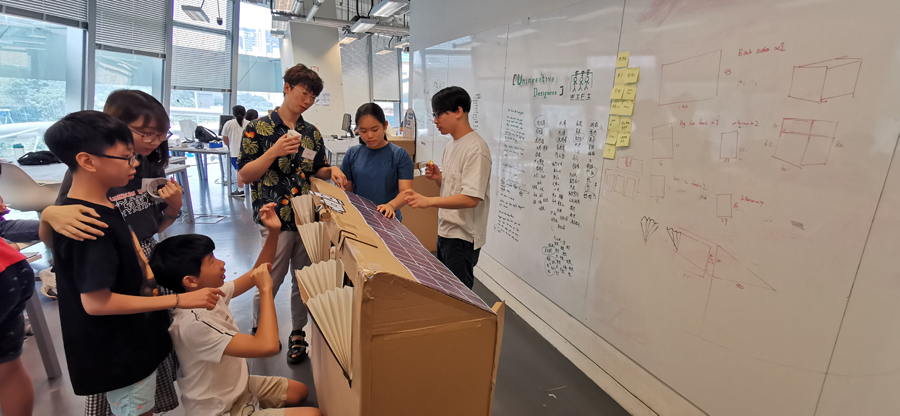Senior-level students (age 12-18) approached the theme “Playful Public Design” as self-directed projects, while our instructors stepped back to allow more freedom for the youngsters to initiate self-chosen problems and design strategies. They learned to prioritize resources such as time and materials to meet a chosen objective of the country park: conservation, leisure or education.
Student’s creative process consists of three stages:
1) Inquiry – investigating user needs
2) Ideation – generating ideas
3) Improvisation – intuitively connecting materials to visualize ideas
Despite the long creative process, student’s motivation was high, resulting in a variety of ideas such as Wild Boar Feeder, Gazebo for Elderlies and Photo-point at the Paperbark Forest. Instructors changed their role to facilitators, to assist in idea development and technical issues.
A group of the students also participated in the Recycling Bins Design Workshop co-led with the Public Design Lab of the Hong Kong Polytechnic University. Under the facilitation of Dr. Paul Lo, they had the opportunity to work with the School of Design’s final-year Product Design students to create new prototypes of a recycling bin, in response to a common phenomenon in the country park – boars breaking trash bins and monkeys unlocking recycling bins to eat human-discarded food. The new recycling bin prototypes addressed inclusive user needs and prevention of animals’ access to human food. Students learned to identify problems, ideate possibilities, choose appropriate solutions and build prototypes. They presented their design outcomes to Professor Michael Siu, founder of the Public Design Lab, and representatives from the Agriculture, Fisheries and Conservation Department of the government.
What our students think about the workshop:
“In the past, I thought a designer just needed to create nice items. Through the workshop I learned that a good designer should make consideration from all users’ perspectives. Our team understood that we should define a core issue among all the problems we examined. Therefore, we mainly wanted to counter the problem where animals started to become dependent on human food from inside the bin, make the job easier for cleaning workers as they would have to hike all the way up onto the hills, and also make it so that the bin can store more rubbish. As a youngster, I was overwhelmed to learn and implement the steps of designing, creating and presenting a product in the university.” – Isaac Wong, age 15, participant
“Before I joined this workshop, I never gave much thought about public design. I never thought about how people design park benches, or other public facilities. Through this three-day experience I learned that to design a rubbish bin you had to think about the many possible users, and how it could fulfil their needs and if it would affect the environment around it. I also learned how something as simple as a rubbish bin could affect the lives of many people, and lives of the wild life!” – Constance Tso, age 14, participant








